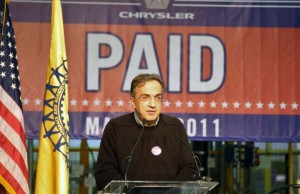As part of its new contract with the United Auto Workers Union, Chrysler will invest $4.5 billion in new vehicles and technology, including two compact models based on Fiat products that will be built at the automaker’s assembly plants in Michigan and Illinois.
But the deal – which also guarantees at least 2,100 new jobs – comes with a price. The union agreed to accept a smaller signing bonus than at General Motors or Ford Motor Co. to help the company achieve financial stability. And only half the $3,500 bonus will be paid immediately upon ratification while the balance will be paid after the company reaches financial stability.
The provision reduces the upfront cost of the contract which also includes a pay increase for second tier workers and limited changes in the health care plans. An additional $1,000 annual bonus also will be deferred until the company is in better financial health, the union said.
The agreement was reached after a series of bruising meeting between UAW President Bob King and Chrysler/Fiat chief executive officer Sergio Marchionne, who had hoped to reduce the cost of the pact while preserving the company’s working relationship with the union. King had said he wasn’t looking for a confrontation with Chrysler but wanted his members to see the contract as fair.
“It’s a new day at Chrysler,” said King, officially confirming the settlement, which came almost a month after the original September 14th deadline.
“In less than 3 years, Chrysler, through the dedication and hard work of its UAW-represented workers, has emerged from bankruptcy, repaid its federal loans six years early and is now helping drive the U.S. economy,” the union chief added. “Through this collective bargaining agreement, we are adding jobs and helping to rebuild America. This proposed contract builds on the momentum created from the UAW General Motors and Ford Motor Co. agreements and will bring 2,100 new jobs to America.”
In total, the three agreements will add more than 20,000 new direct jobs to the economy, with 6,400 jobs at GM, 12,000 at Ford. Significantly, many of those new union positions will be dedicated to handling work that had previously been outsourced to Europe, Mexico and China – as well as outside suppliers in the U.S.
The tentative agreement includes $4.5 billion to produce new and upgraded vehicles and components by 2015.
Jobs, investment and product guarantees in the tentative agreement include:
- Belvidere, Illinois, a new compact vehicle;
- Sterling Heights, Michigan, another new compact vehicle;
- Kokomo, Indiana, a new 9-speed automatic gearbox for front-wheel-drive vehicles and an 8-speed automatic for rear-drive models;
- Toledo, Ohio, next-generation steering columns, and torque converters; and
- Trenton, Michigan, expanded production of Chrysler’s 3.8-liter V-6.
Marchionne made no comments about the contract and is unlikely to say anything until the proposed agreement is ratified by Chrysler 26,000 employees.
Whether U.S. workers will be pleased with the lower payout compared to Ford and GM remains to be seen. But there are others in the trans-Atlantic alliance who are even more likely to have concerns.
Emerging from bankruptcy in 2009 with the assistance of a federal bailout, the White House gave Italy’s Fiat SpA a 20% stake in the Detroit maker and set a series of hurdles by which it could continue building that stake. Fiat now holds more than 50% in Chrysler and will pick up another 5% when it introduces a new high-mileage model in the months to come.
Product development efforts are largely been consolidated, along with purchasing activities and financial operations. Meanwhile, Chrysler CEO Sergio Marchionne – who holds the same post at Fiat — has been using more of a stick with the Italian side of the alliance. That has workers in Europe worried that he will move more of the business – especially production operations – to the U.S. They’re now threatening a one-day walkout this month to protest that prospect.
The comparatively peaceful relationship between the UAW and Chrysler isn’t entirely of choice. The 2009 bailout barred the union from striking over economic issues at Chrysler – and at GM, which also received billions in government aid.
In fact, there was at least one brief flare-up as the talks at Chrysler headquarters in Auburn Hills approached the Sept. 14 deadline. With bargainers still deadlocked over profit-sharing, up-front bonuses and a proposed cap on Tier II employment UAW Pres. Bob King skipped a meeting with CEO Marchionne to focus his efforts on a settlement at GM. That triggered an angry missive from the Canadian-educated CEO which quickly went public.
But the two sides were soon able to patch up their differences and extend their old agreement until October 19. Though there was no deadline bargainers nonetheless felt pressure because the government bailout would have required them to go into arbitration had they reached an impasse.
Barring an unlikely rejection of either the Ford or Chrysler contracts – the GM agreement having been approved last month – UAW leaders will still have plenty of work ahead. One of the key challenges facing them will be to resume long-stalled organizing efforts at the many foreign-owned “transplant” assembly lines that have popped up across the country over the last 25 years. Only two now operating are represented by the UAW.
The trick will be to show that going with the Autoworkers Union will ensure a better livelihood despite the concessions of recent years – and the monthly dues. It may help to portray the “new” UAW as more willing to compromise rather than fight, analysts say.
Paul A. Eisenstein contributed to this report.

